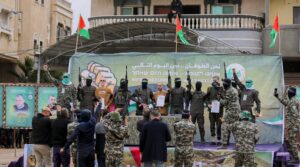By Andrew Adler

Israeli hostages stand on stage flanked by Hamas militants during the official handover in Gaza, Gaza Strip, on Feb. 8, 2025. (Youssef Alzanoun / Middle East Images / Middle East Images via AFP)
If the tortured history of the Middle East has taught us anything, it’s that the transition from war and destruction to peace and tranquility is at best tenuous and at worst catastrophic.
How many times over how many generations have we dared to hope for conflict to be resolved, or at least substantially diminished, only to see those hopes dashed against the rocks of bitter reality (please forgive the ungainly metaphor). This is a region where violence begets violence with numbing regularity, and woe to anyone naïve enough to believe that good intentions alone are sufficient. They almost never are.
Emotions often get the best of us. A few weeks ago, when three female hostages were released after spending 471 days captive inside Hamas’s Gaza tunnels (four more followed soon afterward), the Jewish world erupted in rapturous gratitude. And why not – we and their families had been waiting, praying, crying, imploring for so long – no wonder the news prompted joyful exultation. For a moment, we could nudge the horrors of October 7 to the side in favor of collective celebration.
For a moment.
Then it was time to come back to earth. True, there was a ceasefire in Gaza that appeared to be holding – but really, was a week or two of success cause for genuine optimism? Phase One of a three-phase agreement between Israel and Hamas dangled the prospect of gaining freedom for 33 women, children and men over 50, but we all know that in this region, promises are broken as often as they are kept.
And as if to drive home the point that conflict begets momentum all its own, within days of the ceasefire in Gaza, Israel was conducting what prime minister Benjamin Netanyahu termed an “extensive and significant” operation in and around the West Bank city of Jenin.
Operation Iron Wall, eerily similar to Gaza’s Operation Swords of Iron (not to mention the Iron Dome anti-missile defense system – “Iron” seems to be the Noun du Jour in these parts) represents yet another front for the overburdened Israel Defense Forces, who remain active in Lebanon. The West Bank – which the United Nations and much of the world considers to under illegal Israeli occupation – has devolved from a flashpoint into a morass. Israeli settlers kill Palestinian civilians, Palestinian terrorists kill Israeli settlers (and now, IDF soldiers).
It never, never ends. In Gaza, Hamas looks nothing like an utterly defeated enemy. Israelis celebrated the IDF’s October 16, 2024 assassination of Hamas leader (and October 7 principal architect) Yahya Sinwar, only to wake up not long ago to find Sinwar’s brother, Mohammed, in charge of the organization. Hamas personnel crowded the streets, shouting their slogans and vowing to continue their resistance. As Yogi Berra liked to say, it’s déjà-vu all over again.
So much for Bibi’s vow of total victory. Yes, the IDF has killed thousands of Hamas fighters (along with thousands of Palestinian civilians), slashing the number of Hamas combat troops from 24 battalions to two, but there is a growing consensus that, within Gaza’s shattered cityscapes, there are plenty of fighters-in-waiting eager to take their place. It’s a variation on the truism that you can kill a man, but you can’t kill an idea.
What does this mean for us at home? More uncertainty, that’s what. We can only speculate what Donald Trump and Marco Rubio, his newly-installed Secretary of State, will do in the realm of Middle East policy. Perhaps they’ll devote their energies to building on the Abraham Accords achieved during Trump’s previous term of office – a possible conduit to normalizing relations between Israel and Saudi Arabia (cue rustling in the halls of the Nobel Peace Prize). With Iran, Syria and Lebanon shadows of their former selves, opportunities abound.
Meanwhile, much of our attention remains on Gaza and the remaining hostages, living and dead. Phase One will likely inch forward, hostages trickling out, like the first three bearing Hamas’s “gift bags” containing printed certificates of captivity – an irony that would be laughable were it not so utterly grotesque.
As to Phases Two and Three – well, right now they are mere ciphers. A substantial number of Israelis – not simply far-right politicians like ex-national security minister Itamar Ben-Gvir and finance minister Bezalel Smotrich – want to resume the war in Gaza and, by extension, occupy the Strip permanently. Still others favor annexing the entire West Bank, shattering any prospect for a so-called “two-state solution.”
Here at the Trager Family JCC, a large banner bearing hostages’ names remains standing in the Weisberg Family Lobby, next to an empty chair topped with yellow ribbons. If prayer, politics, fortitude and fortune hold out, the captive hostages eventually will return home, and we may at last consign that banner, and its ribbons, to our shared pangs of memory.
Andrew Adler is Managing Editor of Community.



